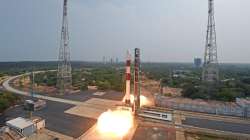ISRO successfully launches PSLV-C55 mission carrying two Singaporean satellites for Earth observation | WATCH
PSLV-C55 is a dedicated commercial PSLV mission of NewSpace India Limited (NSIL), for an international satellite customer from Singapore.

Sriharikota: Indian Space Research Organisations (ISRO) successfully launched its Polar Satellite Launch Vehicle C55 (PSLV-C55) with two Singaporean satellites for Earth observation from the Satish Dhawan Space Centre, Sriharikota at 14.19 hours on Saturday (April 22).
In a textbook launch, the vehicle placed TeLEOS-2 and LUMELITE-4 satellites precisely into their intended 586 km circular orbit.
ISRO Chairperson S Somnath on launch
"Congratulations| PSLV-C55/TeLEOS-2 Mission - the PSLV has placed both satellites in the intended orbit," said ISRO chief S Somanath. Somanath said PSLV placed both satellites into the intended orbit. "The PSLV in its 57th mission has once again demonstrated its high reliablity and its suitability for commercial missions of such class," Somanath said.
"In this mission, we had a core alone configuration of the PSLV which has many specialities and improvements that we made to bring down the cost of the rocket as well as its integration time. And this is the goal--to have increased production and launches of PSLV in the times to come...," Somanath, also Secretary, Department of Space, added Mission Director S R Biju said the "totally dedicated commercial mission" was carried out with "utmost precision."
All you need to know about the launch:
According to ISRO, PSLV-C55 is a dedicated commercial mission through NSIL, with TeLEOS-2 as primary satellite and Lumelite-4 as a co-passenger satellite. The satellites weigh about 741 kg and 16 kg, respectively. Both belong to Singapore. They are intended to be launched into an Eastward low inclination orbit.
TeLEOS-2
The TeLEOS-2 satellite is developed under a partnership between DSTA (representing the Government of Singapore) and ST Engineering. Once deployed and operational, it will be used to support the satellite imagery requirements of various agencies within the Government of Singapore. TeLEOS-2 carries a Synthetic Aperture Radar (SAR) payload. TeLEOS-2 will be able to provide all-weather day and night coverage, and capable of imaging at 1m full-polarimetric resolution.
LUMILITE-4
The LUMELITE-4 satellite is co-developed by the Institute for Infocomm Research (I2R) of A*STAR and Satellite Technology and Research Centre (STAR) of the National University of Singapore. LUMELITE4 is an advanced 12U satellite developed for the technological demonstration of the High-Performance Space-borne VHF Data Exchange System (VDES). Using the VDES communication payload developed by I2R and STAR’s scalable satellite bus platform, it aims to augment Singapore’s e-navigation maritime safety and benefit the global shipping community.
POEM-2
The mission has the PSLV Orbital Experimental Module (POEM), where the spent PS4 stage of the launch vehicle would be utilized as an orbital platform to carryout scientific experiments through non-separating payloads. The payloads belong to ISRO/Department of Space, Bellatrix, Dhruva Space, and Indian Institute of Astrophysics.
The objective of the satellite is to augment Singapore's e-navigation maritime safety and benefit the global shipping community, ISRO said. PSLV C55 mission has been adopted with the 'integrate, transfer and launch' concept using the PSLV integration facility at Sriharikota. It is also the 16th mission for ISRO using the PSLV Core Alone configuration.
Saturday's mission follows the successful deployment of the TeLEOS-1 satellite in a PSLV-C29 rocket along with five other satellites of Singapore in December 2015.
ISRO to launch uncrewed test rocket
The ISRO will launch the first uncrewed test rocket Geosynchronous Satellite Launch Vehicle (GSLV) as a part of the Gaganyaan Mission - India's human space mission. Somanath said that the space agency is planning to send up the first uncrewed GSLV rocket in February 2024 as part of the Gaganyaan Mission. The human module will land in the sea. Somanath said prior that there will a test of the Gagayaan Mission in June this year where the rocket will go up to 12-14 km and test its safety systems.
Queried about the next step in ISRO developing a reusable rocket - similar to the USA's Space Shuttle, Somanath said the space agency will send up an Oribital Recovery Vehicle. The vehicle will be in the space for some days and come back. On forthcoming space missions of ISRO, he said the space agency will send the Aditya L1, Navigation satellites, a commercial launch with the heavier rocket GSLV and a mission with Small Satellite Launch Vehicle (SSLV).
(With agencies input)
Also Read: ISRO successfully launches 'Reusable Launch Vehicle Autonomous Landing Mission' | DETAILS
Also Read: Centre approves Indian Space Policy 2023 to boost private participation

